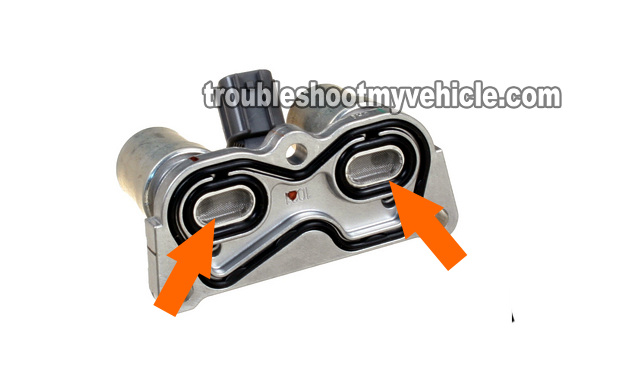TEST 4: Applying 12 V To Solenoid B
So far, you have checked that solenoid valve B, of the lock-up solenoid assembly, is within specification (14 to 25 Ωs)...
... the next step, and the last one, is to manually apply battery voltage to solenoid valve B and check that it makes a ‘clicking’ sound.
If the solenoid doesn't ‘click’, then the solenoid is fried and the whole lock-up solenoid assembly needs to be replaced.
IMPORTANT: Solenoid valve B gets Ground thru' the lock-up solenoid assembly's metal base, so if you do this test with it removed (from the transmission), you'll need to Ground the lock-up solenoid's base directly to your Honda Civic's negative battery terminal.
These are the test steps:
- 1
Unplug the lock up solenoid assembly from its electrical connector.
NOTE: This test is done on the lock-up solenoid's connector AND NOT on the engine wiring harness' pigtail connector. - 2
Apply 12 Volts to terminal #1, of the lock-up solenoid assembly's connector, using a jumper wire or a power probe.
- 3
You should hear an audible click when the 12 Volts are applied.
Repeat this test as many times as you need to be certain of your test results.
CASE 1: Solenoid valve B clicked when you applied battery power. This test result tells you that the solenoid is opening and closing and is operating like it should.
CASE 2: Solenoid valve B DID NOT click when you applied battery power. This test result tells you that solenoid B, of your Honda Civic's lock-up solenoid assembly, has failed.
Since solenoid valve B is part of the lock-up solenoid assembly, you'll need to replace the entire assembly to solve the problem.
Solenoid Assembly Is Good But Transmission Still Not Shifting

If you've tested and found either solenoid (solenoid valve A or B) good and your Honda's transmission isn't slipping yet a lock-up solenoid valve trouble code keeps popping up, I want to suggest two things:
- Remove the solenoid assembly and see if the metal mesh screen filters are clogged and if they are, you should clean them (see photo). Several people have reported that this has solved the issue.
- Check the continuity of the wires between the solenoid assembly and the PCM. You'll need a wiring diagram of your specific Honda to accomplish this test.
Also, and especially after finding no faults in the wiring, there's a good chance that you'll have to replace the lock-up solenoid assembly to completely eliminate it as the source of the problem. I know this isn't something you want to hear, but in some cases this is a necessary thing.
Now, if your Honda's transmission is slipping, then replacing the shift solenoid assembly isn't gonna' help bring the transmission back to normal. Slippage is a direct result of internal damage to the friction discs or hard parts. The only way to solve a slippage issue is overhauling the transmission.

If this info saved the day, buy me a beer!




